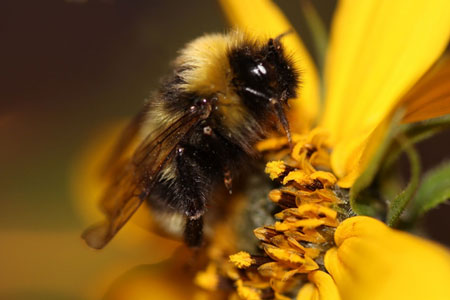Gypsy Cuckoo Bumble Bee

Species information
The following is a report on progress made towards the protection and recovery of Gypsy Cuckoo Bumble Bee (Bombus bohemicus) in Ontario from 2007 to 2022, based on Ontario’s species-specific recovery policy. This report meets the legislative requirement for a review of progress under the Endangered Species Act, 2007 (ESA or “the Act”). Gypsy Cuckoo Bumble Bee is listed as endangered on the Species at Risk in Ontario (SARO) List under the ESA.
Gypsy Cuckoo Bumble Bee was listed as an endangered species under the ESA on March 31, 2015.
Gypsy Cuckoo Bumble Bee has been protected from being killed, harmed, harassed, captured or taken since 2015.
In addition, the habitat of Gypsy Cuckoo Bumble Bee has been protected from being damaged or destroyed since 2015.
The species-specific recovery policy for Gypsy Cuckoo Bumble Bee, known as the Government Response Statement (GRS) was published in 2018 and includes the government’s recovery goal for the species and the actions and priorities it intends to lead or support to help achieve that goal. The GRS considers science advice provided in the recovery strategy (published in 2017), such as species biology, habitat needs, threats to survival, knowledge gaps and approaches to recovery, when developing recovery actions for the species. As legislated in the Act, the purpose of this Review is to report on progress made towards implementing the protection and recovery actions in the GRS. The review can also help identify opportunities to adjust and adapt the implementation of protection and recovery actions to achieve the recovery goal for the species.
Further information about Gypsy Cuckoo Bumble Bee, including the threats that it faces, and actions being taken to help protect and recover this species is available on the Government of Ontario webpage for Gypsy Cuckoo Bumble Bee. A summary on the progress towards the protection and recovery of Gypsy Cuckoo Bumble Bee and an annual update on the broader species at risk program (i.e. the Introduction to the 2023 Review of Progress report) is available on the Review of Progress towards the Protection and Recovery of Ontario’s Species at Risk webpage.
Snapshot: Progress towards the protection and recovery of Gypsy Cuckoo Bumble Bee
Progress towards meeting the recovery goal
- The short-term recovery goal in the Government Response Statement (GRS) for Gypsy Cuckoo Bumble Bee in Ontario is to “support the persistence of the species and its host species at existing locations in Ontario while filling knowledge gaps related to the species’ distribution and the presence and severity of threats.”
- In the long-term, the government’s goal is to “support a self-sustaining Gypsy Cuckoo Bumble Bee population in Ontario by reducing threats to the species and its habitat and encouraging the expansion of populations into suitable areas of its current and known historic range. The government supports investigating the necessity and feasibility of reintroduction, and of augmenting existing populations of Gypsy Cuckoo Bumble Bee and their host species.”
- Progress has been made towards implementing all of the government-led actions. Progress has been made towards implementing all of the government-supported recovery objectives and several of the associated actions. Examples of progress include:
- Developing and implementing a standardized survey and monitoring program for Gypsy Cuckoo Bumble Bee and its host species
- Developing identification tools for the Gypsy Cuckoo Bumble Bee and its host species
- Engaging volunteers throughout the province to participate in citizen science surveys and monitoring efforts for native bumble bees including Gypsy Cuckoo Bumble Bee
- In alignment with the GRS, further work is required to:
- develop, promote and implement best management practices
- develop habitat creation and enhancement guides and initiate or continue habitat management efforts
- encourage the recording, sharing and transfer of Traditional Ecological Knowledge of the Gypsy Cuckoo Bumble Bee
Occurrences and distribution:
- Eighty-seven populations of Gypsy Cuckoo Bumble Bee have been documented throughout Ontario. Currently, one of these populations is extant, whereas the remaining 86 are considered historical Since 2016, nine populations have changed from extant to historical based on a lack of recent observations.
- Since 2008, the government’s central repository at the Natural Heritage Information Centre (NHIC) has received 366 records of the species based on observations between 1883 and 2008.
Government-supported stewardship projects:
- Through the Species at Risk Stewardship Program, the Government of Ontario has enabled its stewardship partners to conduct 11 projects (by providing $479,921 in funding) that have supported the protection and recovery of multiple species at risk including Gypsy Cuckoo Bumble Bee (e.g., landscape-level habitat restoration, or outreach and education focusing on a certain group of species such as those present in a local region).
- The government’s support helped its stewardship partners to involve 164 individuals who volunteered 1,552 hours of their time towards protection and recovery activities for species at risk, including Gypsy Cuckoo Bumble Bee. The estimated value of these voluntary contributions, as well as additional funding and in-kind support, is $863,256.
- Stewardship partners reported that through their actions 38.7 hectares of habitat were enhanced for Gypsy Cuckoo Bumble Bee and other species at risk that inhabit the same ecosystem.
- Stewardship partners reported providing outreach on multiple species at risk, including Gypsy Cuckoo Bumble Bee, to 2,419 individuals.
Supporting human activities while ensuring appropriate support for species recovery:
- The Government of Ontario has issued two permits for this species: both were ‘protection or recovery’ permits issued under clause 17(2)(b) of the ESA.
- Twenty-two activities have been registered for the species. The activities were registered under ‘threats to human health and safety, not imminent’ (section 23.18) and ‘early exploration mining’ (section 23.10) under Ontario Regulation 242/08 of the ESA.
Reporting on the progress towards the protection and recovery of Gypsy Cuckoo Bumble Bee
Recovery Goal
The government’s goal for the recovery of Gypsy Cuckoo Bumble Bee is to support the persistence of the species and its host species at existing locations in Ontario while filling knowledge gaps related to the species’ distribution and the presence and severity of threats.
The long-term goal is to support a self-sustaining Gypsy Cuckoo Bumble Bee population in Ontario by reducing threats to the species and its habitat and encouraging the expansion of populations into suitable areas of its current and known historic range. The government supports investigating the necessity and feasibility of reintroduction, and of augmenting existing populations of Gypsy Cuckoo Bumble Bee and the host species.
The implementation of government-led and government-supported actions demonstrates progress towards reaching the desired objectives and the recovery goal set out in the GRS.
Progress towards implementing government-led actions
Progress has been made towards implementing all government-led actions identified in the GRS. Common actions for the government to lead as it works towards achieving a species’ recovery goal include:
- Work with partners and stakeholders to support pollinator health in Ontario through actions such as integrated pest management and education.
- Educate other agencies and authorities involved in planning and environmental assessment processes on the protection requirements under the ESA.
- Encourage the submission of Gypsy Cuckoo Bumble Bee data to Ontario’s central repository through the citizen science projects that they receive data from (e.g., iNaturalist) and directly through the Natural Heritage Information Centre.
- Undertake communications and outreach to increase public awareness of species at risk in Ontario.
- Continue to protect Gypsy Cuckoo Bumble Bee and its habitat through the ESA.
- Support conservation, agency, municipal and industry partners, and Indigenous communities and organizations to undertake activities to protect and recover Gypsy Cuckoo Bumble Bee. Support will be provided where appropriate through funding, agreements, permits (including conditions) and/or advisory services.
- Encourage collaboration, and establish and communicate annual priority actions for government support in order to reduce duplication of efforts.
Additionally, the government has directly undertaken the following species-specific actions:
- Continue park restoration efforts in habitat where the Gypsy Cuckoo Bumble Bee and its host species have been found in Pinery Provincial Park.
Ontario Parks continues to undertake restoration efforts in habitat where the Gypsy Cuckoo Bumble Bee and its host species (Rusty-patched Bumble Bee (Bombus affinis) and Yellow-banded Bumble Bee (Bombus terricola)) have been found in Pinery Provincial Park. A number of different restoration efforts have been occurring for several years including White-tailed Deer (Odocoileus virginianus) population management, prescribed burns, invasive species management and timing landscaping activities for bumble bee species.
Ontario Parks works with Kettle and Stoney Point First Nation to manage white-tailed deer populations in Pinery Provincial Park through traditional harvesting methods, and works with the Ontario Ministry of Natural Resources (MNRF) to perform culling activities to support the management of healthy ecosystems. When there is an excessive number of White-tailed Deer , the amount of understory vegetation can be reduced; with little to no flowering species, pollinators, especially bumble bees, are negatively affected.
Another issue that negatively affects flowering species is fire suppression. Ontario Parks collaborates with MNRF’s Aviation Forest Fire and Emergency Services to assist with prescribed burning in areas of Pinery Provincial Park. Each year, up to five blocks of varying sizes can undergo prescribed burning to restore and maintain a variety of habitats that benefit species at risk plants and animals such as grassland habitat, oak savannah and oak woodland ecosystems. In 2021, prescribed burning took place in five blocks that ranged in size from 0.60 ha to 16.40 ha.
Monitoring of key at-risk flowering species, such as Blueheart (Buchnera americana) and Dense Blazing Star (Liatris spicata), occurs yearly to ensure populations of those species are maintained within the park. These species are also a key food source for many pollinators including bumble bees. Further efforts to maintain suitable pollinator habitat include mapping and managing invasive species such as Autumn Olive (Elaeagnus umbellate Thunb.) and buckthorn shrubs that crowd out native flora and fauna. Additionally, as Ontario Parks schedules mowing and landscaping work to ensure they are not coinciding with critical timing (regarding ecological processes) for species at risk such as bumble bees.
Key progress made towards implementing these actions is described in the following sections.
Pollinator Health in Ontario
The Government of Ontario has moved to strengthen managed honey bee and wild pollinator populations by working with farmers on ways to promote environmental stewardship, providing education programs and supports for farmers to promote integrated pest management, and addressing pollinators’ exposure to pesticides by reducing the number of acres planted with neonicotinoid-treated corn and soybean seed. Ontario was the first jurisdiction in North America to regulate neonicotinoid-treated seeds.
The Ontario Ministry of Agriculture, Food and Rural Affairs continues to support pollinators and their crucial role in Ontario’s agricultural sector by publishing the 2017 Agronomy Guide for Field Crops (Publication 811), and publishing and updating the Ontario Crop Protection Hub with information on integrated pest management and protecting pollinators, administering cost-sharing programs with beekeepers and farmers, and conducting monitoring, research, education and outreach on insect pollinators. Other ways include:
- supporting managed honey beekeepers and farmers through financial programs, including a range of Business Risk Management programs to help cover loss and damage due to risks that are beyond their control, including AgriInsurance, AgriStability and the Ontario Wildlife Damage Compensation Program.
- identifying annual priorities for funding programs to assist in evidence-informed decision making related to pollinator health and habitats, including through the development of best management practices, prevention and control of pathogens, and management of emerging issues
- supporting projects to improve soil health and water quality that also provide benefits for pollinator habitat (e.g., cover crops, windbreaks and shelter belts, riparian buffers and retiring fragile land) through the Sustainable Canadian Agricultural Partnership funded environmental stewardship programs for farmers.
Occurrences and distribution
Eighty-seven populations of Gypsy Cuckoo Bumble Bee have been documented in Ontario. One population is considered to be extant (i.e., observed within the past 20 years), while 86 are considered to be historical
Since 2008, the government’s central repository at the Natural Heritage Information Centre (NHIC) has received 366 records of the species. These records are based on observations between 1883 and 2008 and come from a variety of sources. Records submitted have helped to refine where the species is known and has been known to occur and have provided additional information on the species’ habitat and threats.
The extant population is due to an observation from 2008 in Pinery Provincial Park. Nine populations have been reclassified from extant to historical since 2016, while the other 77 populations were confirmed to be historical. Despite search efforts in both historical and extant sites, no observations of the Gypsy Cuckoo Bumble Bee have been made since 2008.
It is possible that there are observations of Gypsy Cuckoo Bumble Bee that have not been submitted to the government. Encouraging the submission of observations of this species is included in the GRS as a government-led action. Submission of species observations increases our knowledge of where they occur and can play an important role in assessing the viability of species populations.
Everyone is encouraged, or may be required by an authorization or approval to submit observations of Gypsy Cuckoo Bumble Bee, and any other species at risk observed, to the NHIC for incorporation into the provincial record of observations.
-
366observations of this species were submitted to the NHIC since 2008.
Government-supported stewardship projects
An important government-led action in the GRS for Gypsy Cuckoo Bumble Bee is to support partners to undertake activities to protect and recover the species. Through the Species at Risk Stewardship Program the government has supported 11 projects ($479,921) designed to contribute to the protection and recovery of multiple species at risk including Gypsy Cuckoo Bumble Bee e.g., landscape-level habitat restoration, or outreach and education focusing on a certain group of species such as those present in a local region
In addition to the government funding, partners with projects designed to benefit multiple species including Gypsy Cuckoo Bumble Bee reported they were successful in securing additional funding ($863,256) from other sources. These amounts include in-kind support in the form of time and expertise provided by volunteers.
Stewardship partners reported that provincial funding helped them to secure in-kind support by involving 164 individuals who volunteered 1,552 hours of their time towards protection and recovery activities for multiple species at risk, including Gypsy Cuckoo Bumble Bee, which has an estimated value of $43,872. Partners also reported that through both their efforts and the efforts of their volunteers to implement GRS actions, they were successful in enhancing 38.70 hectares of habitat that will benefit multiple species at risk, including Gypsy Cuckoo Bumble Bee. In addition, stewardship partners reported providing ecosystem-based outreach on multiple species, including Gypsy Cuckoo Bumble Bee, to 2,419 individuals.
The remainder of this section highlights two projects supported through the Species at Risk Stewardship Program as well as the corresponding government-supported recovery actions for the species.
A project implemented by Wildlife Preservation Canada in 2018 demonstrated progress on multiple government-supported recovery actions including: implementing a monitoring program for the Gypsy Cuckoo Bumble Bee and its host species; prioritizing under-sampled areas, historical and extant sites, and in areas with extant populations of the host species (Action No. 1 - High Priority); developing identification tools for Gypsy Cuckoo Bumble Bee and its host species (Action No. 2); and engaging volunteers throughout the province to participate in citizen science surveys and monitoring efforts (Action No. 3). This project conducted a large-scale at-risk bumble bee survey, using both experts and citizen science, which specifically focused on Gypsy Cuckoo Bumble Bee, its host species, and other rare and at-risk species in both historical and extant locations. The project trained volunteers in survey protocols at Pinery Provincial Park and incorporated those data to assist the Park in the adjustment of management practices to protect, maintain and improve habitat for the Gypsy Cuckoo Bumble Bee and its host species. Further research was undertaken to analyze pollen load samples from queen bumble bees to determine if pollen use is altered in rarer species.
Northern Bioscience implemented a project in 2018, using historical observations to establish standardized survey routes for the Gypsy Cuckoo Bumble Bee. This work demonstrated the government-supported recovery objective to develop and implement a standardized survey and monitoring program for Gypsy Cuckoo Bumble Bee and its host species (Action No. 1 - High Priority). In this project, 30 survey routes were determined by choosing sampling locations close to historical records of the Gypsy Cuckoo Bumble Bee (12 routes) and other routes in suitable habitat areas. The surveyors stopped every four km and collected as many bumble bees as possible in 10 minutes using a standard butterfly net. A total of 2,755 bumble bees were collected during these surveys. While no Gypsy Cuckoo Bumble Bees were found, the host species of the Gypsy Cuckoo Bumble Bee (Yellow-banded Bumble Bee) and a relative of the Gypsy Cuckoo Bumble Bee (Fernald Cuckoo Bumble Bee (Bombus flavidus)) were found in the survey. The results indicated that bumble bee abundance was related to roadside flower abundance.
-
 11
11projects including Gypsy Cuckoo Bumble Bee
-
 $479,921
$479,921for projects that included Gypsy Cuckoo Bumble Bee
-
 $863,256
$863,256in additional funding and in-kind support
-
 164
164volunteers
-
 1,552
1,552volunteer hours
-
 2,419
2,419people received outreach
-
 39
39hectares of habitat enhanced
Supporting human activities while ensuring appropriate support for species recovery
Supporting partners through authorizations and their associated conditions is an important government-led action.
Two permits have been issued for Gypsy Cuckoo Bumble Bee since the species has been protected under the ESA, both of which were ‘protection or recovery’ (17(2)(b)) permits. ‘Protection or recovery’ permits are issued if the purpose of the activity is to assist in the protection or recovery of a species at risk. Both permits were issued exclusively for Gypsy Cuckoo Bumble Bee to conduct a Species at Risk Bumble Bee survey in Northern Ontario.
Twenty-two activities that may affect Gypsy Cuckoo Bumble Bee or its habitat have been registered for the purposes of Ontario Regulation 242/08: ‘General’ under the ESA. Twenty-one activities were registered under ‘threats to human health and safety, not imminent’ (section 23.18) and one activity was registered under ‘early exploration mining’ (section 23.10). These registrations require the registrant to comply with all conditions of the regulation, such as:
- preparing a mitigation plan using the best available information on steps that may help minimize or avoid adverse effects on the species
- taking reasonable steps to minimize the adverse effects of the activity on a species and its habitat
- reporting species observations using the Ontario Species at Risk Observation Reporting Form, and submitting them to the NHIC
-
2protection or recovery permits
-
22registrations
Progress towards implementing government-supported actions
Government-supported actions are organized under overarching recovery objectives. Progress has been made towards achieving all government-supported recovery objectives and implementing several of the associated actions identified in the GRS for Gypsy Cuckoo Bumble Bee.
Objective: Increase knowledge of the distribution and abundance of Gypsy Cuckoo Bumble Bee and its host species.
- Action No. 1 (High Priority) – Develop and implement a standardized survey and monitoring program for Gypsy Cuckoo Bumble Bee and its host species, prioritizing surveys in under-sampled areas, historical Gypsy Cuckoo Bumble Bee sites and areas with known extant host populations (i.e., Rusty-patched Bumble Bee and Yellow-banded Bumble Bee), and monitoring in locations where the species is present.
- Action No. 2 – Develop identification tools (e.g., photo-based field guide) for Gypsy Cuckoo Bumble Bee and its host species, to facilitate occurrence submissions through formal monitoring programs or additional observations.
- Action No. 3 – Engage volunteers throughout the province to participate in citizen science survey and monitoring efforts for native bumble bees, including Gypsy Cuckoo Bumble Bee (i.e., BumbleBeeWatch, iNaturalist).
Under this objective, considerable progress has been made towards implementing Action No. 1, 2, and 3.
The first action has been implemented through multiple projects supported by the Species at Risk Stewardship Program. Surveys for the Gypsy Cuckoo Bumble have been completed by multiple partners for multiple years in a row. These surveys took place in a number of areas such as Pinery Provincial Park, historical sites of Gypsy Cuckoo Bumble Bee, sites that have not been previously sampled that have suitable habitat and sites with known extant host populations.
Action No. 2 has been implemented through multiple projects supported by the species at Risk Stewardship Program including one project that provided information on how to best photograph bees for future identification, and another project that provided an identification guide to bumble bees of South Central Ontario and included information on how to submit the sightings on the Bumble Bee Watch website.
The third action has also been implemented through multiple projects supported by the Species at Risk Stewardship Program. A number of partners encouraged observations to be submitted to the Bumble Bee Watch program for areas of suitable habitat for the Gypsy Cuckoo Bumble Bee and where there are extant populations of the host species.
Objective: Maintain or improve habitat and reduce threats to Gypsy Cuckoo Bumble Bee and its host species in or near Pinery Provincial Park, and additional sites if occupied or identified for recovery purposes.
- Action No. 4 (High Priority) – Develop, promote and implement best management practices for landowners, farmers and greenhouse managers surrounding Pinery Provincial Park, and additional sites if occupied or identified for recovery purposes, to reduce potential threats, such as the spread of pathogens and the effects of harmful pesticides or herbicides. Actions may include:
- Minimizing the use of pesticides (e.g., neonicotinoids) and minimizing the impact of herbicides on potential pollen/nectar sources
- Preventing escape of managed bumble bees (e.g., sealing of gaps in greenhouses, freezing colonies before dispersal)
- Monitoring disease and parasite occurrences
- Minimizing the possibility of managed bees foraging at site occupied by Gypsy Cuckoo Bumble Bee
- Developing guidance on how to assess possible impacts to native pollinators when considering the use of herbicides and pesticides
- Promoting buffer zones according to pesticide label statements
- Action No. 5 (High Priority) – Initiate or continue habitat management efforts within suitable habitat where Gypsy Cuckoo Bumble Bee and its hosts have been found (e.g., ensure blooming plants are available from early spring to late autumn, develop habitat management plans to reduce threats and improve habitat suitability.
Under this objective, progress has been made towards implementing Action No. 4, while considerable progress has been made towards implementing Action No. 5.
Both actions were implemented through several projects supported by the Species at Risk Stewardship program. Action No. 4 was implemented by projects that developed and delivered education and outreach programs to landowners about the importance of Bumble Bees and other pollinators, as well as how to create, manage and protect their habitat. Action No. 5 was implemented by a number of projects, one of which completed a prescribed burn in a habitat that was suitable for host species of Gypsy Cuckoo Bumble Bee to encourage the growth of beneficial native flora.
Objective: Improve knowledge of the Gypsy Cuckoo Bumble Bee and its host species and the threats impacting them.
- Action No. 7 (High Priority) – Investigate the necessity and feasibility of augmenting Gypsy Cuckoo Bumble Bee and its host species populations through captive breeding and release or translocation. Actions could include:
- Determining the minimum viable population size and minimum required host abundance to maintain a sustainable Gypsy Cuckoo Bumble Bee population
- Determining habitat requirements and the minimum area required to maintain a sustainable population
- Developing disease screening and gene tracking methods
- Evaluating whether threats can be effectively mitigated at potential recovery sites
- Developing best practices for bumble bee translocation and captive-rearing
- Action No. 8 – Undertake research on basic biology such as forage requirements/behaviour, responses to restoration practices, overwintering requirements, mating behavior, population dynamics and nesting requirements.
- Action No. 9 – Determine the impacts of stressors and combinations of them, such as climate change, insecticides, honey bees and disease.
Under this objective, initial progress has been made towards Actions No. 7, 8 and 9.
Actions No. 7 and 8 have been implemented through multiple projects supported by the Species at Risk Stewardship Program, such as through a project that analyzed population stability of bumble bees through examining phenology, abundance, diversity, and distribution of the Yellow-Banded Bumble Bee queens (a host species of the Gypsy Cuckoo Bumble Bee). Additionally, this project began a Yellow-banded Bumble Bee captive breeding project to work on improving captive breeding techniques, which could then inform breeding techniques for other bee species including Gypsy Cuckoo Bumble Bee. Furthermore, another project analyzed the upregulation of detoxifying genes in the Yellow-banded Bumble Bee to evaluate the effect of stressors on multiple populations.
Action No. 9 was implemented through a project that analyzed the effects of a neonicotinoid pesticide on the reproductive success of the Yellow-banded Bumble Bee.
Summary of progress towards meeting the recovery goal
The short-term recovery goal for Gypsy Cuckoo Bumble Bee is to support the persistence of the species and its host species at existing locations in Ontario while filling knowledge gaps related to the species’ distribution and the presence and severity of threats. The long-term recovery goal is to support a self-sustaining Gypsy Cuckoo Bumble Bee population in Ontario by reducing threats to the species and its habitat and encourage the expansion of populations into suitable areas of its current and known historic range. The government supports investigating the necessity and feasibility of reintroduction, and of augmenting existing populations of Gypsy Cuckoo Bumble Bee and their host species. Effort made towards the government-led and government-supported actions has helped to make progress towards this goal. For example, there have been continual restoration efforts in Pinery Provincial Park where Gypsy Cuckoo Bumble Bee and its host species have been found. The Government of Ontario has also afforded protection to the Gypsy Cuckoo Bumble Bee and its habitat, and continues to work with partners and stakeholders to support pollinator health. Multiple stewardship projects have conducted surveys in extant and historical sites of the Gypsy Cuckoo Bumble Bee, as well as in extant sites of their host species. Additionally, these projects have engaged volunteers to promote citizen science and monitoring efforts for native bumble bees.
Recommendations
As stated in the GRS, this review of progress can be used to help identify whether adjustments to the implementation of GRS actions are needed, to achieve the protection and recovery of the species. Based on progress to date, the overall direction provided in the GRS for Gypsy Cuckoo Bumble Bee, particularly the implementation of actions identified as high priority, should continue to guide protection and recovery of the species.
Although initial progress has been made towards the action to investigate the necessity and feasibility of augmenting the population of Gypsy Cuckoo Bumble Bee, the action to conduct research on basic biology, and the action to determine the impacts of stressors, further work is required to fully implement these actions.
While there has been much focus on the progression of other actions, the following actions require additional support to aid the protection and recovery of the species:
- Action No. 6 – Develop habitat creation and enhancement guides for Gypsy Cuckoo Bumble Bee and its host species (e.g., for use in aggregate and mine site closure and restoration plans).
- Action No. 10 – Research potential best management practices for prescribed burns that consider and mitigate potential impacts to invertebrates with limited dispersal capacity.
Protecting and recovering Gypsy Cuckoo Bumble Bee will continue to be a shared responsibility that will require the involvement of many individuals, organizations and communities. Financial support for the implementation of actions may be available through the Species at Risk Stewardship Program. The government can also advise if any authorizations under the ESA or other legislation may be required to undertake a project. By working together, progress can continue to be made towards protecting and recovering Gypsy Cuckoo Bumble Bee in Ontario.
Footnotes
- footnote[1] Back to paragraph A population is considered historical if it has not been recorded within the last 20 years. Historical populations may still exist, but updated information is not available.
- footnote[2] Back to paragraph Some projects supported through the Species at Risk Stewardship Program may have required a 17(2)(b) permit in order to carry out the project. As a result, some 17(2)(b) permits indicated in this report may have been issued to authorize those projects.